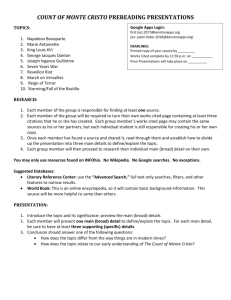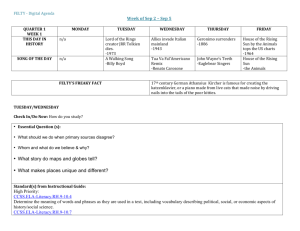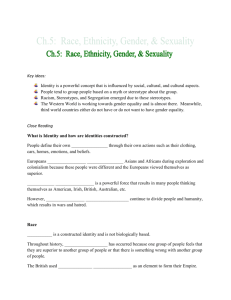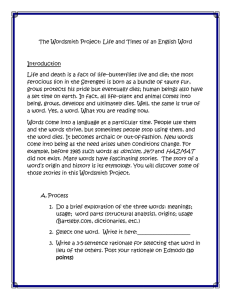Social, Political and Economic Impacts of War
advertisement
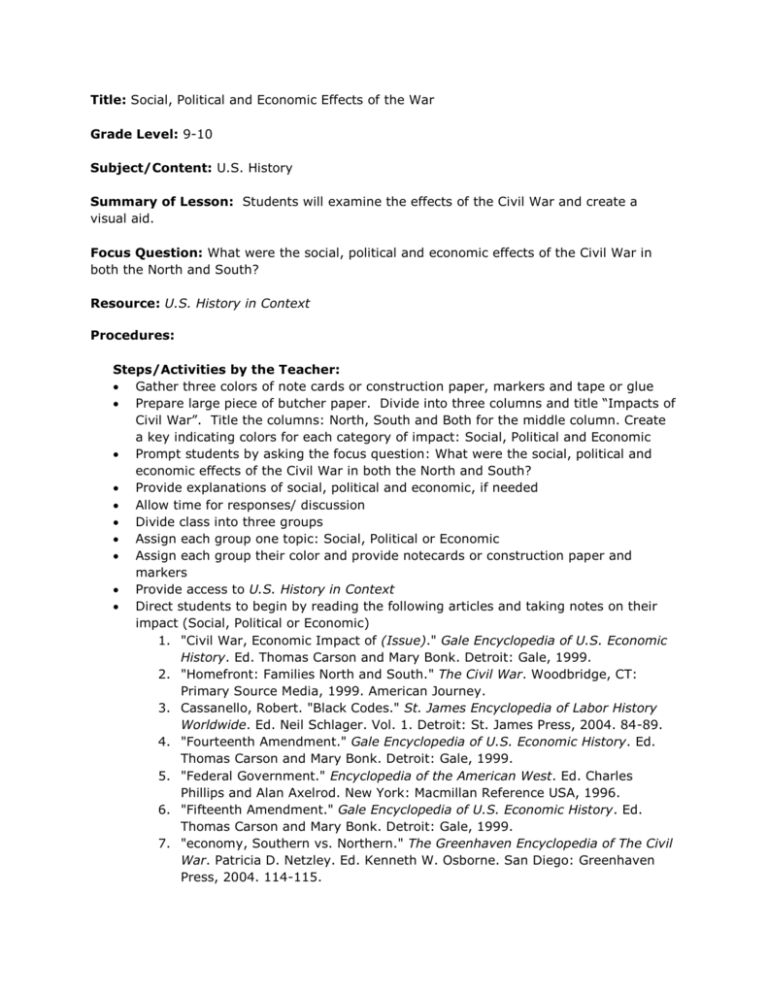
Title: Social, Political and Economic Effects of the War Grade Level: 9-10 Subject/Content: U.S. History Summary of Lesson: Students will examine the effects of the Civil War and create a visual aid. Focus Question: What were the social, political and economic effects of the Civil War in both the North and South? Resource: U.S. History in Context Procedures: Steps/Activities by the Teacher: Gather three colors of note cards or construction paper, markers and tape or glue Prepare large piece of butcher paper. Divide into three columns and title “Impacts of Civil War”. Title the columns: North, South and Both for the middle column. Create a key indicating colors for each category of impact: Social, Political and Economic Prompt students by asking the focus question: What were the social, political and economic effects of the Civil War in both the North and South? Provide explanations of social, political and economic, if needed Allow time for responses/ discussion Divide class into three groups Assign each group one topic: Social, Political or Economic Assign each group their color and provide notecards or construction paper and markers Provide access to U.S. History in Context Direct students to begin by reading the following articles and taking notes on their impact (Social, Political or Economic) 1. "Civil War, Economic Impact of (Issue)." Gale Encyclopedia of U.S. Economic History. Ed. Thomas Carson and Mary Bonk. Detroit: Gale, 1999. 2. "Homefront: Families North and South." The Civil War. Woodbridge, CT: Primary Source Media, 1999. American Journey. 3. Cassanello, Robert. "Black Codes." St. James Encyclopedia of Labor History Worldwide. Ed. Neil Schlager. Vol. 1. Detroit: St. James Press, 2004. 84-89. 4. "Fourteenth Amendment." Gale Encyclopedia of U.S. Economic History. Ed. Thomas Carson and Mary Bonk. Detroit: Gale, 1999. 5. "Federal Government." Encyclopedia of the American West. Ed. Charles Phillips and Alan Axelrod. New York: Macmillan Reference USA, 1996. 6. "Fifteenth Amendment." Gale Encyclopedia of U.S. Economic History. Ed. Thomas Carson and Mary Bonk. Detroit: Gale, 1999. 7. "economy, Southern vs. Northern." The Greenhaven Encyclopedia of The Civil War. Patricia D. Netzley. Ed. Kenneth W. Osborne. San Diego: Greenhaven Press, 2004. 114-115. 8. Hudson, Leonne M. "Food Shortages." Americans at War. Ed. John P. Resch. Vol. 2: 1816-1900. Detroit: Macmillan Reference USA, 2005. 69-70. Direct students to gather at least 15 of their category of impact Allow time for groups to read articles and create note cards Direct students to write impact and brief summary on assigned color of notecard or paper (using markers) Gather class together Place butcher paper chart on wall for all to see Taking turns, allow groups to place their impacts on the butcher paper in appropriate category of North, South or Both Lead discussion throughout activity. Emphasize when specific impacts show up in more than one category (15th Amendment etc.) Leave color-coded visual aid on wall for duration of unit and refer to often Steps/Activities by Student(s): Consider the impacts of the Civil War and engage in discussion Join group and receive assigned topic and color Gather markers, notecards/construction paper Access U.S. History in Context Read the following articles and take notes tracking all impacts of war that fall into your group’s category (Social, Political or Economic). Note if these impacts were experienced in the North, South or both. 1. ""Civil War, Economic Impact of (Issue)." Gale Encyclopedia of U.S. Economic History. Ed. Thomas Carson and Mary Bonk. Detroit: Gale, 1999. 2. "Homefront: Families North and South." The Civil War. Woodbridge, CT: Primary Source Media, 1999. American Journey. 3. Cassanello, Robert. "Black Codes." St. James Encyclopedia of Labor History Worldwide. Ed. Neil Schlager. Vol. 1. Detroit: St. James Press, 2004. 84-89. 4. "Fourteenth Amendment." Gale Encyclopedia of U.S. Economic History. Ed. Thomas Carson and Mary Bonk. Detroit: Gale, 1999. 5. "Federal Government." Encyclopedia of the American West. Ed. Charles Phillips and Alan Axelrod. New York: Macmillan Reference USA, 1996. 6. "Fifteenth Amendment." Gale Encyclopedia of U.S. Economic History. Ed. Thomas Carson and Mary Bonk. Detroit: Gale, 1999. 7. "economy, Southern vs. Northern." The Greenhaven Encyclopedia of The Civil War. Patricia D. Netzley. Ed. Kenneth W. Osborne. San Diego: Greenhaven Press, 2004. 114-115. 8. Hudson, Leonne M. "Food Shortages." Americans at War. Ed. John P. Resch. Vol. 2: 1816-1900. Detroit: Macmillan Reference USA, 2005. 69-70. Review notes and create at least 15 notecards/ construction paper with title of impact and brief summary Bring notes and notecards as class gathers Choose one speaker for your group Taking turns amongst groups, place one notecard/impact in appropriate column of class chart Engage in discussion throughout activity Review chart often throughout unit Outcome: Students will be able identify the impacts of the civil war and categorize as political, economic or social. Related Activities: This lesson can easily connect to the following subjects English Language Arts Assign students one category of impacts to create a media presentation on Learning Expectation: Students will use their reading and note taking skills to explore provided resources. Students will work cooperatively to create impact note cards. Students will engage in discussion during class activity. Standards Alignment Common Core State Standards CCSS. ELA-Literacy.CCRA.R.7 Integrate and evaluate content presented in diverse media and formats, including visually and quantitatively, as well as in words. (Anchor Standard) CCSS. ELA-Literacy.CCRA.R.10 Read and comprehend complex literary and informational texts independently and proficiently. (Anchor Standard) CCSS. ELA-Literacy.CCRA.RI.9-10.10 By the end of grade 9, read and comprehend literacy nonfiction in the grades 9-10 text complexity band proficiently, with scaffolding as needed at the high end of the range. (9) By the end of grade 10, read and comprehend literary nonfiction at the high end of the grades 9-10 text complexity band independently and proficiently. (10) CCSS. ELA-Literacy.SL.9-10.1 Initiate and participate effectively in a range of collaborative discussions (one-on-one, in groups, and teacher-led) with diverse partners on grades 9–10 topics, texts, and issues, building on others’ ideas and expressing their own clearly and persuasively. (9-10) CCSS. ELA-Literacy.SL.9-10.4 Present information, findings, and supporting evidence clearly, concisely, and logically such that listeners can follow the line of reasoning and the organization, development, substance, and style are appropriate to purpose, audience, and task. (9-10) CCSS. ELA-Literacy.L.9-10.1 Demonstrate command of the conventions of standard English grammar and usage when writing or speaking. (9-10) CCSS. ELA-Literacy.RH.9-10.10 By the end of grade 10, read and comprehend history/social studies texts in the grades 9–10 text complexity band independently and proficiently. (9-10) Standard Source: Common Core State Standards Initiative (2010)

